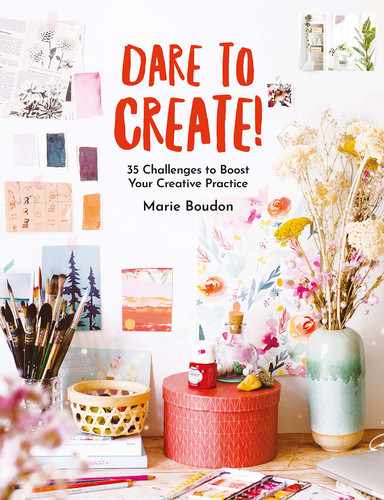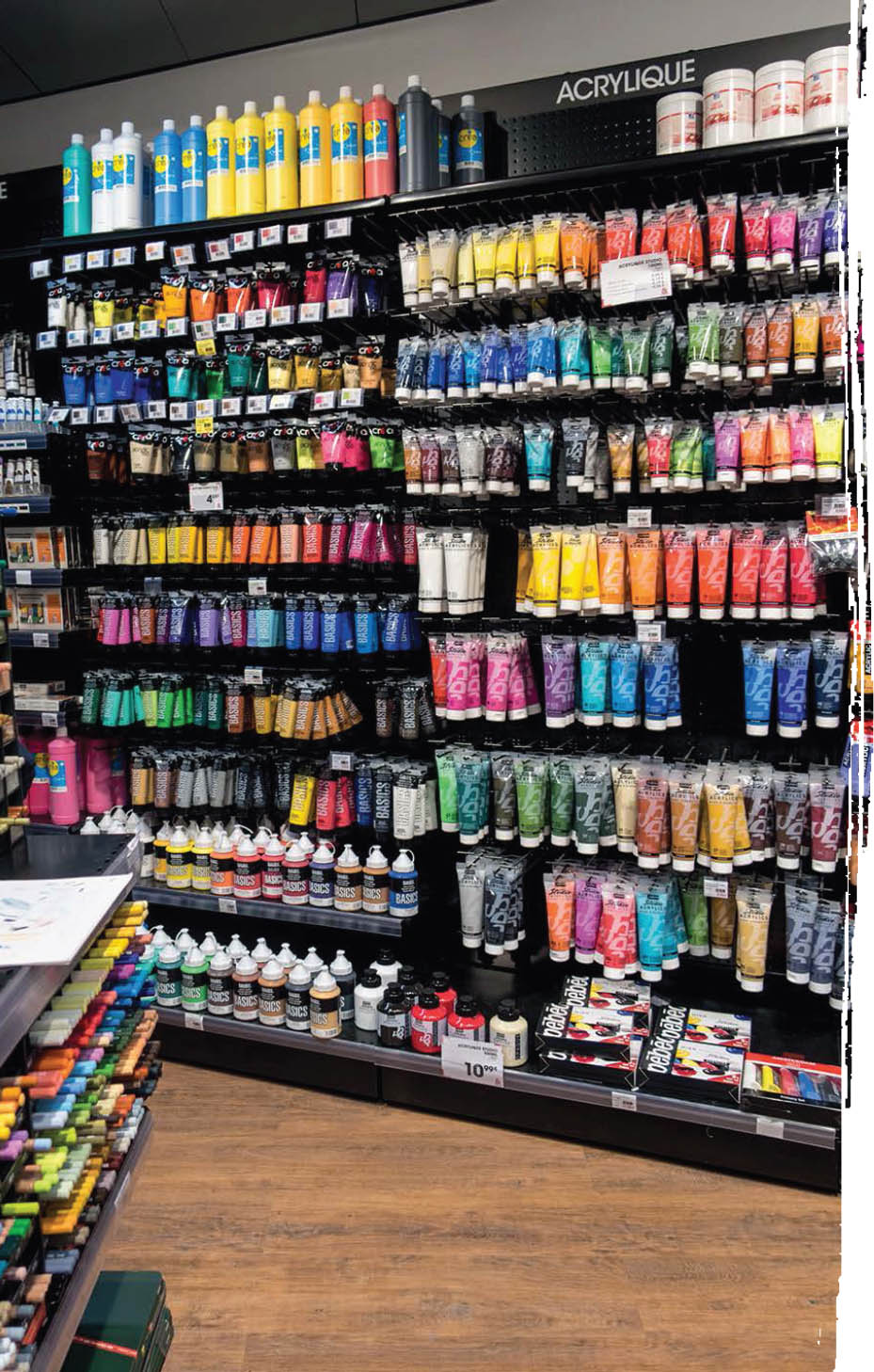 CHALLENGE 5
CHALLENGE 5 
Choosing your artistic practice
ARE YOU READY TO GET STARTED BUT ARE NOT SURE WHAT KIND OF ARTISTIC ACTIVITY YOU WANT TO CHOOSE? IS IT A GOOD IDEA TO PRACTICE SEVERAL OF THEM? THIS CHALLENGE WILL ALLOW YOU TO FIND ANSWERS TO THE QUESTIONS THAT YOU HAVE AND DEFINE THE DIRECTION YOU SHOULD TAKE.
Discovery phase
Faced with the plethora of activities available, it can be hard to choose one. If you are able to, I suggest that you try out the practice you are interested in before fully committing. Borrow the materials you need from a friend or take part in a workshop so that you can “feel” the medium and how you respond to it.
How can you tell whether this medium is right for you? Georgia O’Keeffe, the American painter, explained it like this: “I found I could say things with color and shapes that I couldn’t say any other way—things I had no words for.” Any medium might be the right one for you. Don’t go in with your mind already made up. There is no practice that is “just for professionals,” “too complicated for you,” or, for that matter, “too old-fashioned.” For me personally, I was reluctant to get started with watercolors because I thought that the medium had gone out of style. But no medium is out of style, and you do not have to follow any rules. It’s up to you to decide what you want to do with it and what approach you want to take!
Most of the time, though, you will already have some idea of which disciplines are attractive to you. Above all, follow your intuition. If you have tried out one kind of practice and felt a connection, didn’t notice the time going by, asked a lot of questions, and felt curious about it and inspired, these feelings are all good signs that you should maybe follow your exploration into this practice.
There is no need to keep thinking about it for months: just allow yourself to try it out with a small budget, and then don’t be afraid to switch activities if you start to feel that it isn’t for you. I’m not saying that you should give up whenever there is the smallest obstacle, but just that if you sense that a path is not right for you, you should feel free to follow another one.
The following questions and comments may also be helpful to you as you make your choice:
![]() Who are your favorite artists? What do you like about their work? What are you intrigued by? What are you obsessed with? It would surely be a good idea to try out their technique.
Who are your favorite artists? What do you like about their work? What are you intrigued by? What are you obsessed with? It would surely be a good idea to try out their technique.
![]() Which of your senses do you want to mobilize? If you want to work with your hands, pottery or painting might make you happy. If it is images that interest you, have you tried photography?
Which of your senses do you want to mobilize? If you want to work with your hands, pottery or painting might make you happy. If it is images that interest you, have you tried photography?
![]() Are you a collector or a minimalist? Your artistic practice can be adapted to your lifestyle. If you don’t want to be overwhelmed by papers and markers, have you thought about digital art? A tablet or a computer could be enough for you to start creating with.
Are you a collector or a minimalist? Your artistic practice can be adapted to your lifestyle. If you don’t want to be overwhelmed by papers and markers, have you thought about digital art? A tablet or a computer could be enough for you to start creating with.
![]() What kind of budget will you need for the discipline you’re interested in? Look into whether it matches your constraints. Be aware that most of the time, it is possible to just stick with the basics. For example, photography can become very expensive, but it can also be very accessible: just using a smartphone, you can already learn a lot.
What kind of budget will you need for the discipline you’re interested in? Look into whether it matches your constraints. Be aware that most of the time, it is possible to just stick with the basics. For example, photography can become very expensive, but it can also be very accessible: just using a smartphone, you can already learn a lot.
![]() Do you need some specialized equipment for the activity you’re excited about? I’m thinking about the use of a press for engraving, or a darkroom for developing photo prints. You should think ahead about these issues as you are choosing your practice.
Do you need some specialized equipment for the activity you’re excited about? I’m thinking about the use of a press for engraving, or a darkroom for developing photo prints. You should think ahead about these issues as you are choosing your practice.
![]() What attracts you to a particular artistic practice? For example, photography, videography, and comic strips are well suited to telling stories. Collaging lends itself perfectly to experimenting with materials. Watercolors are ideal for relaxing while watching colors blend. Art journaling (creating art journals using a variety of techniques to express emotions or recount events) is an excellent way to document daily life. Calligraphy involves very detailed work. And so on.
What attracts you to a particular artistic practice? For example, photography, videography, and comic strips are well suited to telling stories. Collaging lends itself perfectly to experimenting with materials. Watercolors are ideal for relaxing while watching colors blend. Art journaling (creating art journals using a variety of techniques to express emotions or recount events) is an excellent way to document daily life. Calligraphy involves very detailed work. And so on.
Whether or not you have a chance to try it out, I recommend that you start by exploring no more than one practice, especially as a self-taught beginner. Mastering a technique takes time and requires concentration. What Bruce Lee said about this was: “I fear not the man who has practiced 10,000 kicks once, but I fear the man who has practiced one kick 10,000 times.” Channeling your energy into this one particular practice will allow you to improve quickly. As time goes on, you will develop skills and a style that you can always use later in other mediums as well. But if, on the other hand, you start on three or four different kinds of practice at once, you run the risk of getting discouraged.
Nurturing yourself through other disciplines
Sometimes, however, you might find it essential to try out other mediums or practices. If there is one that you prefer, that doesn’t mean that you can’t allow yourself to try others. According to the American writer, poet, and painter Daniel A. Miller, practicing several different artistic specialties at the same time allows for artistic cross-pollination. In other words, one practice will nurture the other, and alternating among the various activities will stimulate your curiosity. A second creative activity will often be the ideal solution to allow you to think new thoughts, avoid boredom, or just get out of your comfort zone.
If you master several different artistic specialties, you’re adding more strings to your bow. You can choose the one that suits you best in terms of the message that you are trying to express. This is the approach that many artists take, including the British painter and illustrator Oliver Jeffers, who works in watercolors, oil, and digital art, depending on the project and the target audience (children’s books, exhibits, etc.).
Finally, your specialty could be something that is at the intersection of several different practices. In other words, you might combine several mediums to compose your creations, without necessarily being a master of all of them (see, for example, the technique of Deeann Rieves, whose story is on page 116). In order to find out, the only way is to try!
In the long interview that Matisse gave to the critic Pierre Courthion in 1941 (published in Chatting with Henri Matisse: The Lost 1941 Interview), the painter said: “I took up sculpture because what interested me in painting was a clarification of my ideas. I changed mediums, I picked up clay to take a rest from painting, in which I had absolutely done everything that I could for the time being. It was done for the purpose of organization, to put order into my feelings and to find a style to suit me. When I found it in sculpture, it helped me in my painting.”
The choice of artistic practice is intimately connected with the notion of identity. If, in the long term, you intend to become a professional at your art, then your identity, more than your style, will be your guide. The American author Austin Kleon confirms this in his book Steal Like an Artist: “Don’t be afraid to go all over the place. What unifies your work is that you are the author.” So don’t hesitate to experiment with a number of different practices or styles. Over time, your identity will shine through even beyond your productions (for instance, in your communications and your brand image).
![]() Your Turn
Your Turn ![]()
- 1. Make a list of the artistic practices you would like to try.
- 2. If you’re a beginner and you’re teaching yourself, I would suggest that you choose one favorite practice to start with. If possible, try it out before committing yourself.
- 3. If you feel as though it is a combination of techniques that is interesting to you, then, by all means, go in that direction.


